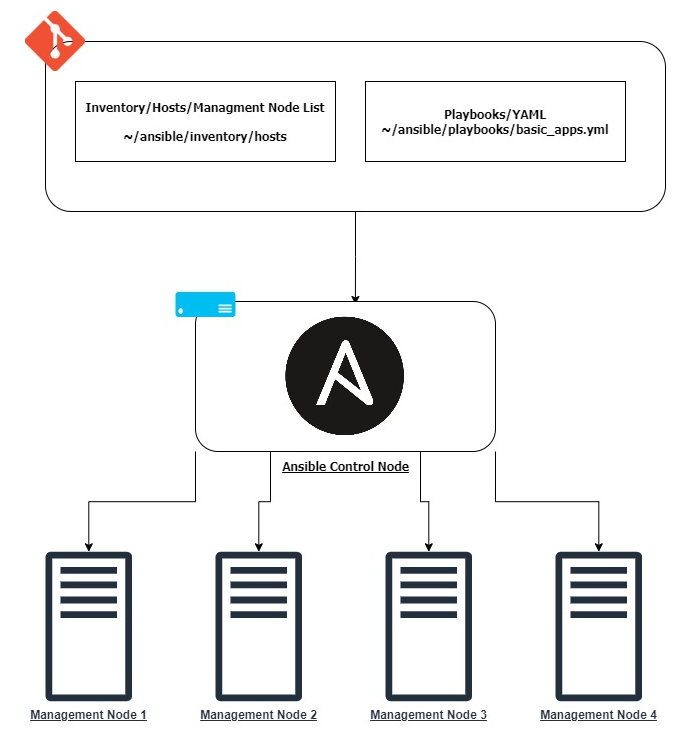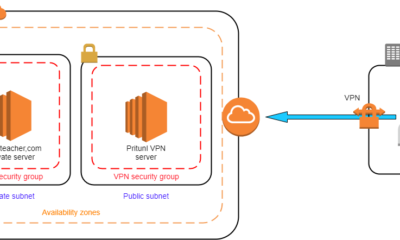DevOps
How to Use Ansible to Manage Linux Hosts Efficiently
Are you tired of manually handling each Linux host in your network? Imagine having a tool that simplifies and automates these tasks, saving you time and reducing errors.
Ansible can be your game-changer. It’s a powerful, open-source automation tool that can revolutionize the way you manage your Linux hosts. With Ansible, you have the ability to streamline processes, increase efficiency, and focus on what truly matters. This guide will walk you through using Ansible to manage your Linux systems effortlessly.
Stick around to uncover how you can harness Ansible’s full potential and transform your workflow.
Benefits Of Ansible For Linux Management
Ansible simplifies Linux host management through automation, enhancing efficiency and reducing manual tasks. Its straightforward syntax and powerful modules enable seamless configuration and deployment, ensuring consistent environments. By leveraging Ansible’s scalability, Linux administrators can easily handle multiple hosts, achieving streamlined operations and improved system reliability.
Managing Linux hosts can be a daunting task, especially when you’re dealing with multiple servers and configurations. Ansible steps in as a powerful tool, simplifying this process with its automation capabilities. By using Ansible, you can streamline the management of your Linux systems, making your life easier and your work more efficient. Let’s explore the benefits of Ansible for Linux management.1. Easy Configuration Management
Ansible allows you to manage configurations across your Linux hosts with ease. You write playbooks in YAML format—simple and human-readable. This makes it accessible even if you’re not a programming expert. Imagine updating a configuration file across hundreds of servers with just one command. Ansible makes this possible without breaking a sweat.2. Agentless Architecture
One of Ansible’s key advantages is its agentless architecture. You don’t need to install any software on the hosts you’re managing. Ansible uses SSH to connect, meaning less hassle for you and less overhead on your systems. It’s like having a remote control for your Linux hosts, without needing to set up additional infrastructure.3. Scalability
Whether you’re managing ten servers or a thousand, Ansible scales effortlessly. It’s built to handle large environments without compromising on performance. Have you ever struggled with scaling your management tools as your infrastructure grows? Ansible is designed to expand with you, keeping your operations smooth and efficient.4. Repeatable Processes
Ansible ensures that your processes are repeatable and reliable. You can write playbooks to automate tasks that you perform regularly, ensuring consistency every time they are executed. This means fewer mistakes and more predictability in your workflows. Think about how much time you could save by automating repetitive tasks with Ansible.5. Integration With Other Tools
Ansible integrates seamlessly with other tools in your tech stack. Whether you’re using Jenkins for CI/CD or Docker for containerization, Ansible plays well with others. This integration means you can create a cohesive environment where all your tools work together. Have you ever wished for a smoother workflow across different systems? Ansible’s compatibility can make that a reality.6. Community Support
The Ansible community is vibrant and supportive, providing a wealth of resources and shared knowledge. From forums to tutorials, there’s a plethora of information available to help you troubleshoot issues or learn new tricks. Have you ever been stuck on a problem with no idea where to turn? With Ansible, there’s a community ready to lend a hand. Incorporating Ansible into your Linux management strategy can transform how you handle your systems. The benefits are clear and achievable, making it a worthy addition to your toolkit. What challenges are you facing in Linux management today that Ansible could help solve?
Credit: docs.orcharhino.com
Installing Ansible
Ansible simplifies the management of Linux hosts. Begin by installing Ansible using package managers like apt or yum. This tool automates tasks, ensuring efficient administration of multiple systems through playbooks and modules.
Installing Ansible can seem daunting if you’re new to managing Linux hosts, but it’s simpler than you might think. Whether you’re a seasoned sysadmin or just starting your journey, Ansible can be a game-changer in automating tasks. Let’s break down the steps to get Ansible up and running on your system.System Requirements
Before you start, make sure your system meets the necessary requirements. Ansible is quite flexible, but a few basics are essential. You’ll need a Linux-based operating system, such as Ubuntu, CentOS, or Fedora. Ansible requires Python 3.6 or newer, so check your Python version by typing `python3 –version` in your terminal. If needed, update Python to a compatible version. Ensure your system has internet access to download Ansible packages. A stable connection will save you from potential download errors.Installation Steps
Now that your system is ready, let’s install Ansible. The process is straightforward, and you can do it quickly. 1. Update Your System: Start by updating your package manager to ensure you have the latest software lists. Use the command `sudo apt update` on Ubuntu or `sudo yum update` on CentOS. 2. Install Ansible: Once updated, install Ansible with a simple command. On Ubuntu, you can use `sudo apt install ansible`. For CentOS, the command is `sudo yum install ansible`. 3. Verify the Installation: After installation, verify it by checking the version. Type `ansible –version` in your terminal. You should see the current version number, confirming that Ansible is installed correctly. Doesn’t it feel rewarding to see that version number pop up? It’s a small victory that opens the door to more efficient system management. Now, with Ansible installed, you’re ready to automate, manage, and orchestrate your Linux hosts like a pro.Configuring Ansible Inventory
Managing Linux hosts with Ansible involves configuring the inventory file. This file lists all target machines. Organize hosts into groups for efficient control.
Configuring Ansible Inventory is essential for managing Linux hosts efficiently. Ansible uses an inventory file to define the systems it controls. This file lists all the hosts and groups. It helps Ansible know where to apply configurations. Understanding this setup is crucial for effective automation.Defining Hosts
Begin by defining hosts in the inventory file. Each host has an entry with its IP or hostname. This tells Ansible where each system is. Use plain text to list hosts. Keep it simple and organized. Example: “` 192.168.1.10 myhost.example.com “` This makes it easy for Ansible to connect. Ensure each host is reachable. Check IP addresses for accuracy.Grouping Hosts
Grouping hosts simplifies management. It allows applying configurations to multiple systems at once. Use square brackets to define a group. List hosts under the group name. Example: “` [webservers] 192.168.1.10 192.168.1.11 “` This groups all web servers together. Apply tasks to the entire group quickly. Adjust as needed for your environment. Use descriptive group names. It makes your inventory easier to read.
Credit: www.geeksforgeeks.org
Writing Ansible Playbooks
Writing Ansible playbooks is a crucial skill for managing Linux hosts. Playbooks are YAML files that define tasks for configuration management. They automate processes, ensuring consistency across systems. Understanding their structure and common modules can simplify tasks significantly.
Playbook Structure
Every Ansible playbook starts with a basic structure. It includes a list of plays, each detailing hosts, tasks, and variables. The playbook begins with a name, describing its purpose. Then, specify the hosts it targets. Tasks within plays detail actions to perform on those hosts. Each task has a name, making it easy to understand its function. Variables provide dynamic content, adapting tasks to different scenarios.
Common Modules
Ansible offers various modules to accomplish tasks efficiently. The ‘file’ module manages file attributes, permissions, and ownership. The ‘yum’ module installs packages on Red Hat-based systems. For Debian-based systems, use the ‘apt’ module. The ‘service’ module controls services, ensuring they’re running or stopped. The ‘copy’ module transfers files from control machines to hosts. These modules simplify many routine tasks.
Executing Ansible Playbooks
Executing Ansible Playbooks is a crucial task for managing Linux hosts. It automates repetitive tasks and ensures consistency. Playbooks are written in YAML, a simple language. They describe the desired state of the system. This section explores running commands and handling errors in playbooks.
Running Commands
Running commands with Ansible Playbooks is straightforward. Each playbook consists of tasks. Each task executes a specific command. Use the shell or command module to run commands. The shell module allows complex shell commands. It supports piping, redirects, and variables. The command module is simpler and more secure. It does not support shell features. Choose the right module based on your needs.
Use the ansible-playbook command to run a playbook. Specify the playbook file as an argument. For example: ansible-playbook playbook.yml. This command applies the playbook to all hosts in the inventory. Add options for more control. Use -i to specify a different inventory file. Use --limit to run the playbook on specific hosts.
Handling Errors
Handling errors in Ansible is important. It ensures tasks run smoothly. Ansible provides several options for error handling. Use the ignore_errors directive to continue on error. Set it to yes for specific tasks. This option is useful for non-critical tasks.
Use the failed_when directive for custom error conditions. Define a condition under which a task fails. This option gives more control over task outcomes. Use the register directive to capture task output. Analyze the output to handle errors gracefully. Use conditionals to decide the next steps. This approach helps in building robust playbooks.
Using Roles For Organization
Organize Linux host management with Ansible roles for streamlined efficiency. Ansible roles simplify tasks by grouping them logically. This approach enhances clarity, ensuring smoother operations and easier maintenance.
In your journey to manage Linux hosts with Ansible, using roles can be a game-changer. Roles help you organize your playbooks and tasks into manageable, reusable pieces. They make your code cleaner and easier to maintain. Think of roles as a way to categorize your Ansible tasks, making complex configurations simpler to handle. If you’ve been struggling with keeping your Ansible projects organized, roles might be the solution you need. ###Role Structure
Roles bring structure to your Ansible projects. They are a way to bundle multiple tasks, variables, files, and templates together. Each role is like a folder with a specific layout. Inside a role, you typically have directories like `tasks`, `handlers`, `vars`, `files`, and `templates`. This setup keeps everything neatly organized. It also means you can easily find what you need when making updates or troubleshooting issues. Here’s a simple look at what a role structure might include: – tasks/: Contains the main list of tasks to be executed. – handlers/: Holds tasks triggered by `notify` directives. – vars/: Houses variables associated with the role. – files/: Contains files to be copied to the remote machines. – templates/: Stores templates that Ansible will fill with variable data. Doesn’t that sound like a breath of fresh air for your workflow? ###Creating And Using Roles
Creating roles is straightforward. Start by setting up the directory structure as outlined above. You can use the `ansible-galaxy init` command to automatically create a new role structure. This command takes care of the initial setup, allowing you to focus on writing tasks. Once your role structure is in place, populate the directories with your Ansible scripts and resources. For instance, put your usual playbook tasks in the `tasks/main.yml` file. Utilize the `vars` directory to define any variables specific to the role. Using roles in your playbooks is just as easy. Simply reference the role in your playbook’s `roles` section. For example: “`yaml – hosts: webservers roles: – apache “` This playbook tells Ansible to apply the `apache` role to all hosts in the `webservers` group. Roles can significantly reduce complexity. They allow you to reuse code across different playbooks and projects. Are there roles you could start implementing today to streamline your tasks? Roles not only save time but also improve the reliability of your configurations. If you’ve ever found yourself duplicating tasks across multiple playbooks, roles are your new best friend. They help you maintain consistency and reduce errors. By adopting roles, you can focus more on solving complex problems and less on managing repetitive tasks. Isn’t that what efficient automation is all about?Automating Tasks With Ansible
Manage Linux hosts effortlessly with Ansible’s automation. Install software, configure systems, and perform updates using simple playbooks. Streamline processes and enhance efficiency without complex scripts.
Automating tasks can greatly ease the management of Linux hosts. Ansible stands out as a powerful tool for this purpose. It allows users to automate repetitive tasks, saving time and reducing errors. By using Ansible, you ensure consistency across your systems. This section explores how Ansible can automate tasks effectively.Scheduling With Cron
Ansible can integrate with Cron for task scheduling. Cron jobs automate tasks by running them at set intervals. With Ansible, you can manage these Cron jobs across multiple Linux hosts. This integration simplifies task management and ensures timely execution. Using Ansible playbooks, you can define tasks and their schedules. These playbooks can be applied consistently across all hosts. This consistency reduces the risk of human error. It also ensures that tasks run as intended. For administrators, this means less manual oversight and more reliability.Using Ansible Tower
Ansible Tower adds a graphical layer to Ansible automation. This tool provides a user-friendly interface for managing tasks. With Ansible Tower, monitoring task execution becomes simpler. It offers dashboards and notifications, helping track task progress. Ansible Tower also supports role-based access control. This feature ensures that only authorized users manage tasks. It enhances security by limiting access to sensitive operations. For teams, this means better collaboration without compromising security. The visual interface and enhanced features make Ansible Tower an excellent addition.
Credit: blog.devops.dev
Troubleshooting Common Issues
Managing Linux hosts with Ansible can sometimes bring challenges. Beginners may face common issues. Troubleshooting these can save time and reduce stress. This section provides guidance on common problems. Learn how to debug playbooks and fix connection problems.
Debugging Playbooks
Playbooks are the heart of Ansible automation. Mistakes in them can cause errors. To debug, use the -vvv option. This increases verbosity and shows detailed output. Look for syntax errors or incorrect module usage. Validate your YAML syntax with online tools.
Always check variable names for typos. Use the ansible-playbook --syntax-check command. This helps find syntax issues before running.
Resolving Connection Problems
Connection issues often stem from SSH problems. Verify SSH configuration on your Linux hosts. Ensure the correct SSH keys are used. Check the SSH port settings as well. The default is usually port 22.
Network issues can also cause connection failures. Ensure that your network allows SSH traffic. Use the ping module to test connectivity.
If you see authentication errors, check your Ansible inventory file. Ensure the correct username and password are set. For password-less connections, confirm SSH key permissions.
Frequently Asked Questions
What Is Ansible Used For In Linux?
Ansible is used for automating configuration, management, and deployment of Linux hosts. It enables efficient system updates, software installations, and task automation. By simplifying complex processes, Ansible improves productivity and reduces errors, making it a valuable tool for system administrators managing multiple Linux machines.
How Does Ansible Manage Linux Hosts?
Ansible manages Linux hosts using SSH connections without requiring any agents on the hosts. It employs playbooks written in YAML to define tasks. These tasks are executed on remote hosts, ensuring consistent configuration and updates. This agentless architecture simplifies setup and enhances security by minimizing vulnerabilities.
Can Ansible Be Used Without Root Access?
Yes, Ansible can be used without root access on Linux hosts. It supports privilege escalation using sudo or other methods. Users can specify tasks requiring elevated privileges while maintaining control over access levels. This flexibility allows for secure management of hosts without compromising administrative boundaries.
Is Ansible Suitable For Beginners?
Ansible is suitable for beginners due to its straightforward syntax and extensive documentation. Its YAML-based playbooks are easy to write and understand. With a large community and numerous tutorials available, newcomers can quickly learn to automate tasks and manage Linux hosts effectively with Ansible.
Conclusion
Ansible simplifies managing Linux hosts. Its tools are efficient and straightforward. Automation saves time and reduces errors. You gain more control over your systems. Setup is easy, and scripts are reusable. Learning Ansible opens doors to better management strategies. Start with basic tasks.
Gradually move to complex ones. The community offers great support. You can find tutorials and examples online. Ansible can transform your Linux management approach. Use it to streamline processes and enhance productivity. Embrace this tool for effective system administration. Your Linux environment will benefit greatly.
-

 DevOps6 years ago
DevOps6 years agoSaltstack Tutorial for beginners [2025]
-

 DevOps6 years ago
DevOps6 years agoHow to build a Docker cron job Container easily [2025]
-

 Linux6 years ago
Linux6 years agomail Command in Linux/Unix with 10+ Examples [2025]
-

 DevOps6 years ago
DevOps6 years agoDocker ADD vs COPY vs VOLUME – [2025]
-

 DevOps6 years ago
DevOps6 years agoHow to setup Pritunl VPN on AWS to Access Servers
-

 Linux6 years ago
Linux6 years agoGrep Command In Unix/Linux with 25+ Examples [2025]
-

 Linux6 years ago
Linux6 years agoFind command in Unix/Linux with 30+ Examples [2025]
-
Linux5 years ago
How To setup Django with Postgres, Nginx, and Gunicorn on Ubuntu 20.04

